At PNGIBR we believe that scientists have a responsibility to present and explain their research to the general public, to the scientific community and to policy makers and implementers. And to share a conservation message on how we can all work together for a biologically sustainable future.
- We share our knowledge and research results by:
- Publishing our research in peer reviewed scientific journals
- Presenting our results at scientific meetings and in talks to government bodies and to the public
- Giving guest lectures for the Conservation Education Program at University of Goroka
- Providing reports and recommendations to policy makers, partners and stakeholders
- Making awareness materials like leaflets, posters and field guides for protected areas
- Extensive discussions and outreach with landowners throughout PNG
Opportunities for Awareness Work
We have had many opportunities for awareness work. Here are some examples:
- A previously trained Crater Mountain landowner was recruited by IBR to train Gahavisuka landowners in climbing techniques using a harness. Through this interaction the Crater landowner was able to share his people’s experience in working with non-profits to protect a wildlife management area with the landowners of the Mt. Gahavisuka Provincial Park.
- Through partnership with The Mama Graun Conservation Trust Fund (MGCTF), Michael Kigl conducted consultation and awareness workshops with Mt. Gahavisuka Provincial Park (GPP) and Mt. Wilhelm National Park (WNP) landowners, community based organizations, guest houseoperators and tour guides; the PNG Department of Environment and Conservation; the Goroka McCarthy Museum; Chairman of the GPP Board of Trustees; Eastern Highlands Department of Environment and Natural Resources; Office of the Secretariat; Office of Provincial Assistant Administrator, District Services, Simbu Province; Provincial Offices of Culture and Tourism; Environment/Climate Change Office, Simbu;and Sangamanga Culture &
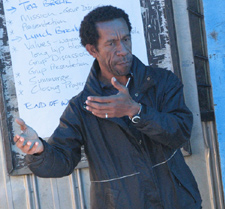
Michael Kigl
Environment Protection. The workshops were not only geared towards getting a collective view on landowners awareness for conserving their flora and fauna and cultural heritage, but also their thoughts on reviving the two parks after a period of neglect. Four workshops are planned for each site. The first workshop for GPP was held 2-12 October 2009 at the Nagamiza village near the Park and attracted 59 participants including landowners. The first workshop for WNP was held at Kegesugl in the Gembogl District (Simbu Province) 9 -11 November 2009. The workshop was conducted in the local Kuman language and had 79 participants including land owners. The participants expressed gratitude at having been recognized as an integral partner in the community-based, bottom-up planning process for the parks rejuvenation.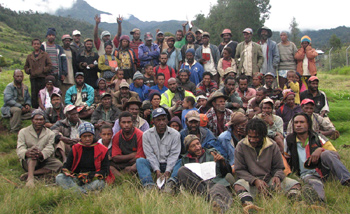
Mt. Wilhem participants
- Several IBR staff and students have given guest lectures on their research to University of Goroka students in the University’s Conservation Education class taught by the Research and Conservation Foundation of PNG.
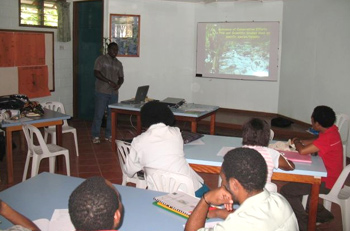
University of Goroka lecture
- Junior Novera from IBR gave a guest lecture for University of Goroka final year students about the importance of conservation in PNG. Junior used his honors project as a case study on how hunting studies are crucial for designing sustainable management plans for game species in rural communities. He also gave an overview of the many challenges to conservation in PNG and what can be done to prioritize conservation initiatives both locally and globally.
- IBR staff and students participated in the various World Environment Day (June 5th 2009) celebrations and talks around Goroka. A major forum attended by Goroka-based schools and the general public was conducted near the centre of town where IBR Co-Director, Banak Gamui, gave a speech on the much talked about effects of climate change and highlighted issues and misconceptions about carbon trade. Daniel Solomon, intern biologist, represented IBR and gave a speech at the Goroka Secondary School. Paul Igag gave a talk at a primary school outside of Goroka town. At each of these events we gave out information leaflets highlighting the points talked about.
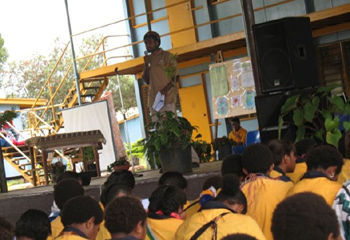
Earth Day celebration
- The Institute of National Affairs (INA), Research and Conservation Foundation (RCF) of PNG, and IBR jointly supported two public talks by well known visiting scientists to Papua New Guinea. Dr. Allen Allison of the Bishop Museum in Hawaii on the 5th of March 2009 at Ela Beach Hotel, Port Moresby. Dr Allison’s talk was on Diversity and Global Significance of the Ecology of Papua New Guinea and the local benefits it also provides. The second talk was delivered on 15th of June by Dr. Robert Johns on The Vegetation of New Guinea Its Classification, Biodiversity and Conservation, with observations on the effects of Population and Carbon Trading. Dr. Johns was one of the pioneer ecologists who studied alpine vegetation at Mt. Wilhelm and other areas of Papua New Guinea.
- IBR Co-Director Miriam Supuma represents the Melanesia region on the board of the Society of Conservation Biology-Oceania. A recent publication on conservation priorities for the oceania region was published: Conservation Focus: Priorities for Policy-Relevant Conservation Research: a View from SCB Regional Sections. Major Conservation Policy Issues for Biodiversity in Oceania. Conservation Biology 23: 834-840. Using IBR networks, Miriam collated views from conservationists, academics, students, policy makers and from people who have worked in Melanesia and presented them to the SCB-O board members for use in this paper. IBR thus played a role in bringing to light issues affecting Melanesia, so that policy makers can use such documents to formulate guidelines for better management of our rich biodiversity.
- Every time PNGIBR researchers go into or out of an area through a village they explain their projects, how these projects are important for conserving local wildlife, and general conservation issues of importance in that area. For example, when Banak, Kenneth, Junior, Aileen and Samoa were leaving the Mekil Conservation Initiative passing through the Sokamin Village after their sustainable hunting fieldtrip they held a conservation awareness session. They talked about how their study results might affect the lives of local people who are
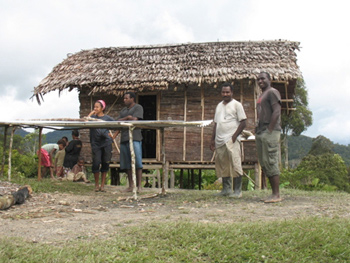
The team waiting for the crowd to gather at Sokamin
heavily dependent on hunting. Based on his analyses Kenneth told villagers that their favorite game animal (the ground cuscus Phalangergymnotis) was being overhunted but bandicoots (Echymipera sp.) were doing fine. That this could be because ground cuscus usually only produce one young at a time, which stays in the mother’s pouch for up to seven months, and when they kill the mother they also kill the young. And that because this species of cuscus dens on the ground instead of in trees it is easily found by introduced dogs which people use to track game. On the other hand, bandicoots have up to three young at a time and begin reproducing at a very young age (they are very fecund). They suggested management strategies of 1) hunting many species instead of focusing on only one to spread the hunting pressure, 2) hunting smaller animals instead of larger ones that usually have lower reproductive rates, and 3) to try to take males instead of females if they could tell the difference before killing the animal.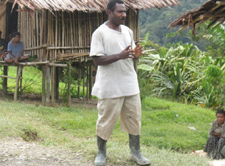
Banak giving his awareness talk
- Enock Kale of IBR represented PNG landowners and presented a talk entitled Landowner perspective on partnership with local communities for long-term forest conservation during the REDD workshop meeting organized by the PNG Institute of National Affairs in Port Moresby from 1 – 3rd March 2010. Some government officials and many development partners were present at the workshop. His talk was aimed at ensuring that local people are meaningfully involved in any forest conservation and or sustainable development projects on their land (97% of PNG land is in private hands).
- In July 2009, IBR ran a two-week biodiversity survey of the Hogave Conservation Project with landowners of the area, documenting birds, mammals, ants, and plants. The landowners had themselves looked after their forest and had policed it as a protected area for 20 years. Through this survey, PNGIBR staff biologists and local assistants constructed species lists in both the local language and in scientific language for the project and congratulated the landowners for a job well done, agreeing to partner with them in the future.
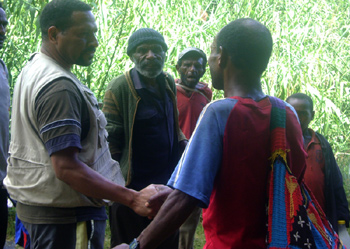
Enock explaining biodiversity surveys to landowners
- IBR staff and students attended a two day Climate Change Workshop (11-12 May 2009) at the University of Goroka. The workshop was organised by the
Office of Environment and Climate Change. It was refreshing to see IBR students critique and ask questions relating to policies governing climate change in the country. - IBR was represented by Miriam Supuma at the University of James Cook, Cairns Australia for a three day workshop from 22-24 October 2009. The workshop focused on monitoring rainforest wildlife in Papua New Guinea. It is hoped that the ideas drawn from participants will form a standard species monitoring protocol which will be tested at the YUS Conservation Area, Morobe Province.
